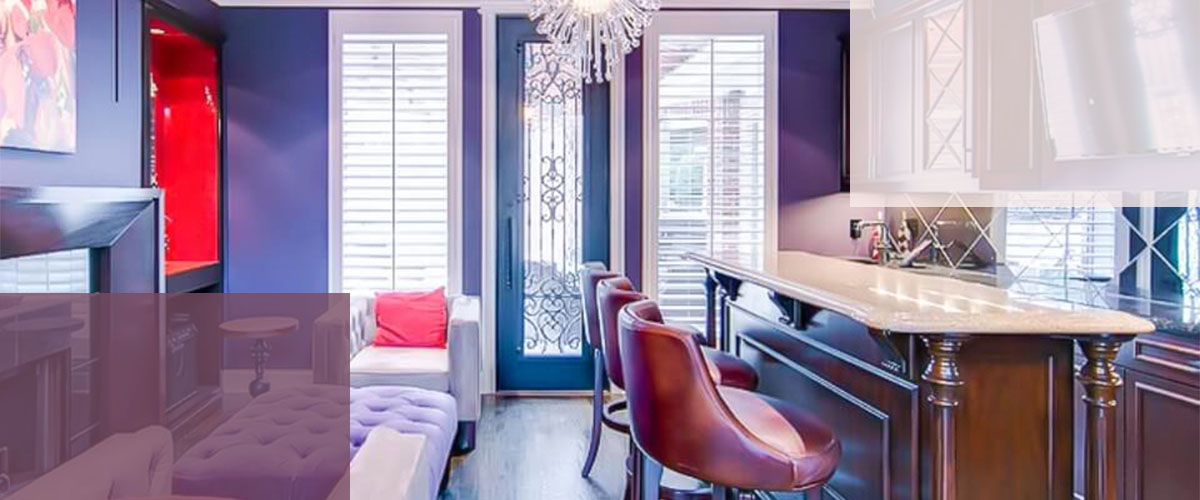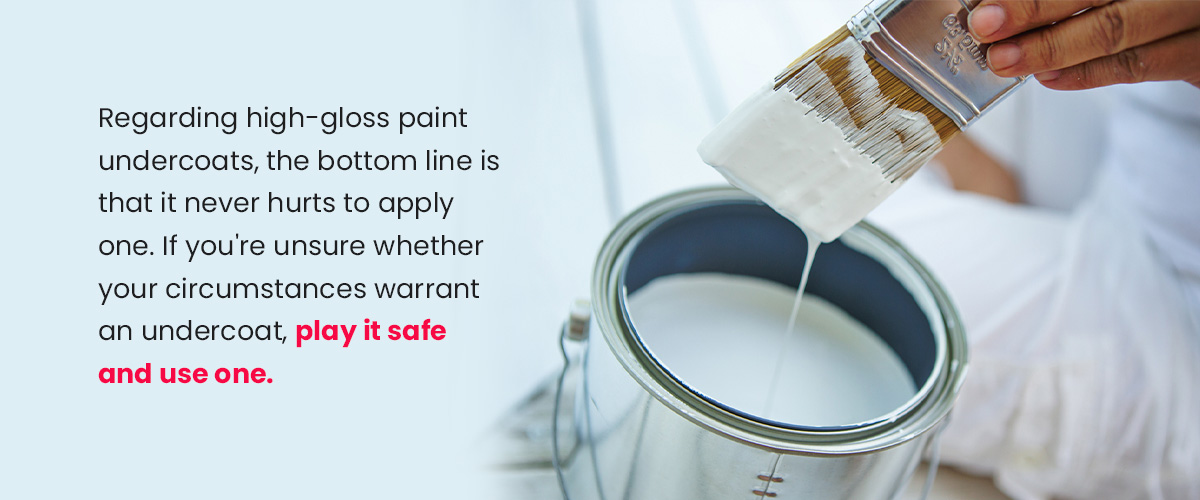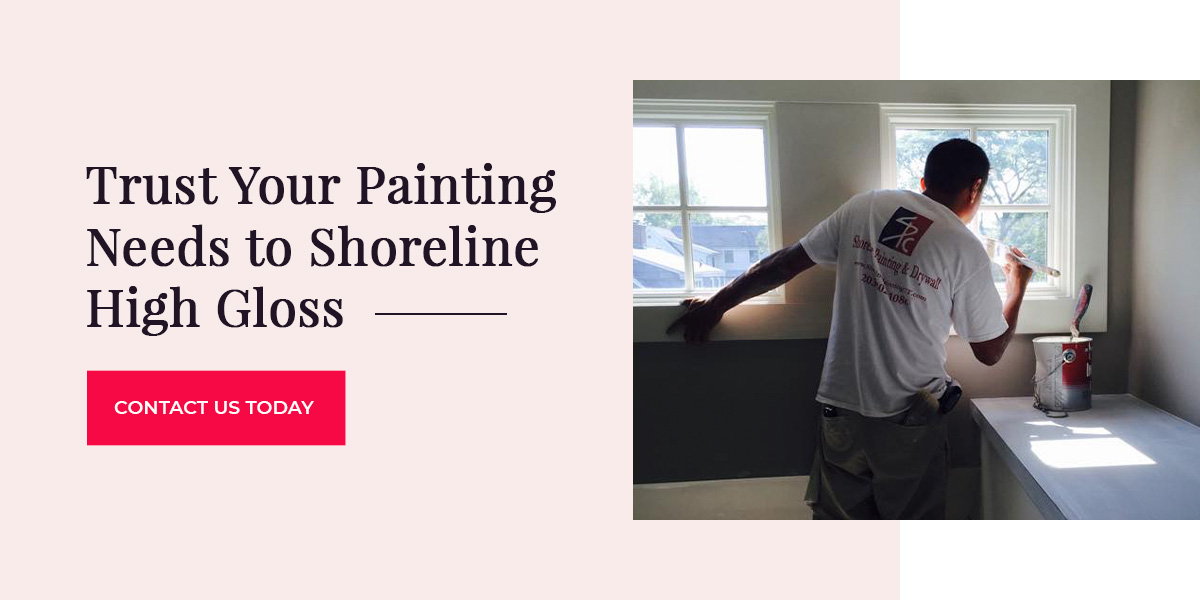Surfaces painted with a high gloss have a smooth, shiny and reflective appearance. High gloss paint is ideal for adding dimension, detail and interest to any surface, including interior and exterior doors, cabinets, ceilings, trim, accent walls and high-traffic areas.
Preparation is crucial when using high gloss paint. Undercoats, sanding and priming are often necessary to achieve a high-quality finish. Read on to learn more about undercoats and when to apply them.
Primer vs. Sealer vs. Undercoat
Primers, sealers and undercoats are three preparatory coatings that serve different functions. Let’s define each to help you understand their role and purpose in the painting process.
Primer
A primer is the first coat of paint applied to a surface. It improves porosity to ensure that subsequent paint layers adhere strongly.
A coat of primer can also:
- Neutralize stains
- Prevent seeping or bleeding between layers of paint
- Prevent the formation of rust on metal surfaces
- Flatten out imperfections on uneven surfaces
- Form a barrier so moisture can’t reach the topcoat
- Prevent the development of mold and fungus
Sealer
Sealers are a special prep coat to use with or in place of a primer. A sealer provides good adhesion between the surface and the primer or topcoat. When using a sealer, apply it before the primer. Sealers are excellent for reconditioning old surfaces to make them suitable for painting. They fill in porous areas on the surface to prevent the topcoat from soaking in and create a water-resistant shield between the surface and the topcoat.
Additionally, sealers can help retain any waxes on the surface and prevent the painted surface from staining.
Undercoat
An undercoat goes on after the primer. It fills any remaining imperfections, creating a flat, level and neutral-colored base for the topcoat to adhere to. Undercoats also help lighten a surface when transitioning from darker to lighter colors.
Undercoats are pigmented and work best with enamel topcoats. When layered over a primer or sealer, undercoats fortify and bolster their function. The resulting foundation is a robust and moisture-resistant barrier that forms a solid base for additional coats of paint.
Does High Gloss Paint Need An Undercoat?
It’s generally best to use an undercoat before applying high gloss paint. Our professionals apply an undercoat before high gloss paint in the following situations:
- When there is a dramatic color change: Perhaps you’ve decided to transition from a rich hue to a light tone. or maybe you’re going from a vibrant color to something more muted. When you make such a dramatic color change, the transition should be seamless. An undercoat blocks out the underlying color, allowing the new high gloss paint color to apply evenly. You can choose shades of undercoat that closely match your topcoat to ensure the final color is full and rich.
- When the surface is bare, in which case you’ll also need a primer: Raw wood, newly installed drywall or fresh plaster are incredibly porous. When you apply gloss paint directly to these materials, the paint can soak in unevenly, leading to blotchy patches or streaks. An undercoat creates a seal over the porous surface to regulate the absorption of the high gloss paint. Without this barrier, it’ll detract from the elegant and sleek finish of gloss paint.
- When the surface is in poor condition: If you paint over a wall with wear and tear, even a thin coat of gloss paint will magnify every imperfection. An undercoat fills in these flaws and creates a consistent base that prevents them from shining through after applying the high gloss. It provides a strong and stable surface for the gloss to adhere to and reduces the likelihood of peeling or fading.
- When the existing paint is a gloss: Glossy surfaces tend to be slippery, which can prevent the new coat of paint from bonding as desired. An undercoat creates a better bond between the existing paint and the new high gloss layer and can help prevent it from peeling in the future.
- When painting over textured surfaces: Applying an undercoat helps to mitigate the impact of the texture and ensures the gloss coat will go on smoothly.
In addition to using an undercoat, it’s almost always necessary to sand the surface before applying gloss paint. Sanding removes imperfections and adds adhesion by creating small, rough ridges for the color to bond to.
It never hurts to apply high gloss paint undercoats. If you’re unsure whether your circumstances warrant an undercoat, play it safe and use one.
Should You Prime Before Painting With High Gloss?
Whether you need to prime before painting depends on the surface. For example, metal surfaces need a primer before adding high gloss paint. Otherwise, the color will flake off almost immediately. Depending on their condition, wooden surfaces may need priming and undercoating before painting. Primer prevents walls made from plaster or concrete from absorbing the paint.
The professionals at Shoreline High Gloss usually only need to sand and coat the previously painted area before applying new high gloss paint. They can spot-prime any bare or troublesome areas. Following are a few additional scenarios in which a high gloss paint primer is necessary.
If the Walls Are Porous
Primer is a necessity when painting porous surfaces. If there isn’t a barrier to protect them, they can absorb moisture, oil, stains and odors. Examples of porous surfaces include unstained or untreated wood and drywall. These will absorb paint without a coat of primer to seal them.
Applying high gloss paint directly onto a porous surface can lead to an uneven finish. Priming helps create a more uniform color and improves the adhesion of the gloss paint.
If the Walls Are Glossy
Glossy finishes create a barrier that makes it difficult for the new paint to stick. Without priming, the new high gloss layer may peel off, crack or develop an uneven texture. Whether your walls are shellacked wood paneling or covered with gloss paint or enamel, they’ll need priming and sanding before you apply indoor gloss paint on walls. This step ensures the surface has enough texture to grip the primer and paint. The result? A smooth finish that will last longer and retain its shine for years to come.
If the Walls Are Stained
If your walls have stains from water damage, smoke or a kid’s art project, priming is a necessary first step. High gloss paint won’t effectively cover stains or mask discoloration. Depending on the cause, the stain may bleed through the new coat and mar the final result. Primer acts as a blocker, sealing stains so they won’t permeate the new paint.
Before applying primer to stains, you must address the issue that caused them in the first place. If your walls have water stains, repair the leak before painting. Unaddressed leaks can cause mold growth, which is a health hazard.
If the Walls Have an Odor
If previous residents had pets, smoked, cooked pungent foods or dealt with a fire, the walls might have absorbed and retained those scents. Painting over an odor-filled surface won’t solve the problem. Instead, the odors may seep through the new paint and undermine your efforts to freshen up the space. A primer can seal in strong odors and eliminate them so they don’t return.
Regular paint formulations don’t permanently keep odors away, so don’t skip the priming step when sealing out strong smells.
If You Are Drastically Changing the Color
Priming is necessary when switching from a very dark to a very light color or from one vivid hue to another. Heavily saturated paint colors can show through paler, lighter shades. Priming these colors first means you won’t need several coats of paint to cover them up.
Trust Your Painting Needs to Shoreline High Gloss
At Shoreline High Gloss, we understand what it takes to produce a beautiful, long-lasting paint job. We have decades of experience delighting homeowners in New York City and Palm Beach, Fla., with our expertise and professionalism. High gloss finishes are our specialty, so contact us today if you’re ready to take your home to bold new heights.
- Site Credits
- Sitemap
- Privacy Policy
- COPYRIGHT © 2020. ALL RIGHTS RESERVED
- Back to top



